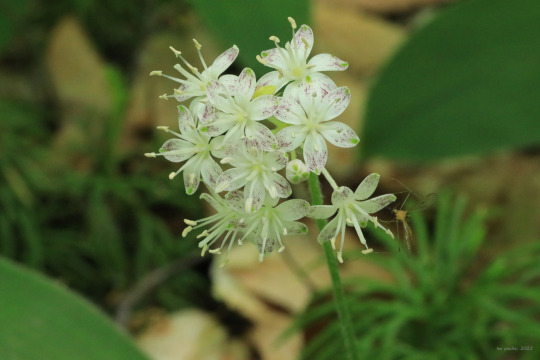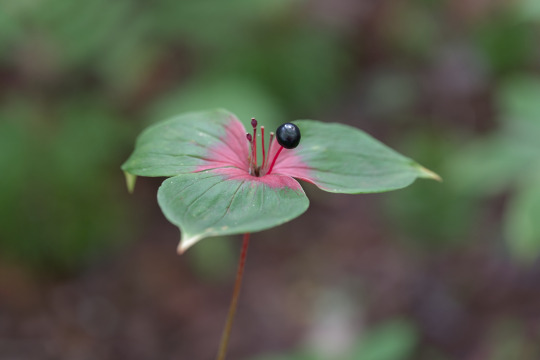#indian cucumber-root
Photo










A magnet for adventure tourists and nature lovers, Ohiopyle State Park sprawls across twenty thousand square acres of steeply-sloped wild lands on the flanks of the Youghiogheny River Gorge in Pennsylvania’s Laurel Highlands. The Great Allegheny Passage bike trail runs through the heart of the park, which also anchors a thriving whitewater rafting industry. I fortunately live within a short drive of the park, so a day hike is always in the cards. Especially on a beautiful Memorial Day holiday.
From top: black raspberry (Rubus occidentalis), an aggressive colonizer with delicious fruit coveted by humans and animals alike; longstyle sweetroot (Osmorhiza longistylis), also known as anise root, because its roots have a licorice-like flavor; Indian cucumber (Medeola virginiana), easily identified by its two tiers of whorled leaves and odd, pendulous flowers; and speckled wood lily (Clintonia umbellulata), also known as white Clintonia or black-bead lily, a close relative of yellow Clintonia (Clintonia borealis), which tends to occur at higher elevations in Central Appalachia.
#appalachia#vandalia#pennsylvania#laurel highlands#allegheny mountains#youghiogheny river#ohiopyle state park#black raspberry#longstyle sweetroot#anise root#indian cucumber#indian cucumber-root#speckled wood lily#white clintonia#black-bead lily#may#spring#wildflowers#flora#jonathan run#eelah trail#jonathan run trail
318 notes
·
View notes
Text
Honoring the Lady's Slippers
It’s become a tradition for us to spend Memorial Day or at least a day during this weekend searching for one of My Guy’s favorite blooms. I don’t even remember how the count began, but now he cannot not count them.
What we’ve learned over the years is that they like a variety of habitats. from dark forests to bogs, and even mountain tops. And they like to hide. So we must really don our Lady’s…

View On WordPress
#Clintonia#Common Whitetail Skimmer#Indian Cucumber-root#Lady&039;s Slipper#Maine#Memorial Day#western Maine
0 notes
Photo

Indian Cucumber Root
44 notes
·
View notes
Text

Herbs And Spices For Health And To Spice Up Vegetarian Cooking
One reason some people don’t stick with a vegetarian lifestyle is they feel it gets monotonous, no one likes having the same kind of foods repeatedly, and we don’t blame you. The problem is often people don’t know quite how to add variety to their dishes, instead they just make what they know.
Read on to learn our best tips for creating new and exciting dishes and for adding pizazz using herbs and spices to the old favourites you love.
Health Benefits Of Herbs
All herbs and spices are vegan as they originate from plants, including flowers, seeds, fruits, leaves, roots, and barks.
First, let’s talk a little bit about the quality of herbs and spices. Besides being low calorie flavour powerhouses, fresh herbs provide distinct health benefits and some even have healing powers.
Many herbs and spices contain antibacterial and antiviral properties. Many are also high in trace minerals and B-vitamins. They contain antioxidants that help prevent disease and improve wellness; here are just a few examples.
Basil
Basil is a very flavourful and diverse herb (typically used in Italian dishes) that can be added to many dishes and recipes. Basil has anti-inflammatory and antiviral properties and is believed to help prevent osteoarthritis. Fresh basil can be used in salads, soups, stews, sauces sprinkled over eggs, and steamed vegetables.
Dill Weed and Seed
Dill has a fresh and unique flavour, and potent antibacterial properties. It is helps to settle upset stomach and queasiness. Fresh, uncooked dill is best for health and flavour. A salad with tomatoes, cucumbers, onion slices, fresh dill, and an oil and vinegar drizzle is an old Russian favourite and tastes really great.
Cayenne Pepper
Cayenne pepper is used medically to increase circulation, and as a cream for joint pain, such as that related to arthritis conditions. Cayenne also revs metabolism, not a lot, but every little bit helps.
Cayenne ads a nutty, smoky flavour to food and of course heat (spiciness). It can be used to add a kick to boring vegetables, in sauces, soups, tofu stir-fries, and stews.
Mint
Mint is a pungent herb that helps ease nausea and alleviate digestive problems. It is often used in dessert recipes, but also tastes great when used fresh in sauces, salads and in tea.
Turmeric
Turmeric is most commonly used in Indian dishes, and sadly greatly overlooked as a spice in American kitchens. It contains a compound called Curcumin, which is a cancer-fighting agent.
In the U.S., it is widely used as a medicine for those with inflammation and joint problems. Turmeric can be added to vegan curry, soups, stews, sprinkled over vegetables, in sauces and muffins.
Garlic
Fresh garlic is flavourful, diverse, supports heart health, and has anti-cancer properties. Use garlic fresh and raw from the clove no longer than 15 minutes after preparation to prevent the loss of disease fighting anthocyanins that it contains. Garlic can be used in sauces, over salads, grated over steamed vegetables, and in hundreds of recipes to provide great flavour.
Herbs And Vegetarian Diets
Fresh herbs are a great addition to many dishes, both raw and cooked. Herbs and spices can add a completely new dimension to an old dish. For instance, you can make a dish Italian, or add an Asian flair with the right combination of spices, let’s look at some of the regionally based spices that will give your dull dish a tasty makeover.
If you’re looking for something reminiscent of your favourite Italian dish, get an Italian flavoured seasoning. Oregano is loaded with antioxidants; it has cancer-fighting agents. It is also a natural antiviral and antibiotic.
The oil and leaves of Oregano are used medicinally to treat body aches, fever, and cold symptoms. You can also make your own blend with staples of Italian cooking that include basil, marjoram, garlic, oregano, rosemary and thyme to create a powerful anti-bacterial, antimicrobial and cancer fighting blend. This blend and Oregano by itself can be used in sauces, stews, over vegetables, in pasta dishes and in salads.
Asian flavours can really change the dynamic of your vegetarian dish. Soy sauce is a fundamental in Asian cooking and is used in all sorts of dishes. Rice Vinegar is another staple that can really change how you feel about boring salad vinaigrette; rice vinegar has a mild sweet tang and is the fundamental for many dipping sauces you find in Chinese foods.
Asian style cuisines often use things like coconut milk to add flavor and smooth creamy texture to soups.
Fresh ginger has a potent, sweet flavour, is often used to make soups, in salads and in marinades. It can be a fantastic addition to a vegetarian dish or even eaten on its own when marinated. Ginger is great for cleaning the palate.
Never underestimate the power of a properly coupled dish. Some things just go together. Here are some of those great combinations.
Asparagus: Lemon, Garlic and Tarragon
Cauliflower: Chives, Coriander, Sage and even Turmeric
Mushrooms: Garlic, Marjoram, Nutmeg, Sage, Thyme
Zucchini: Basil and Oregano
Sweet Potatoes: Allspice Cloves, and Nutmeg
Potatoes: Rosemary, thyme parsley
These are just a few examples of great pairs you can create with just vegetables alone. Even adding these spices to a standard steamed veggie dish can give a lot more depth and interest to the vegetables themselves.
Another thing to keep in mind is proper seasoning; the use of salt and pepper is designed to bring out the flavours in a dish. Vegetarian dishes are no exception.
Make sure to add the right amount of salt (not too much) and pepper to your dish to bring out the bright and brilliant flavours the vegetables have to offer.
A Word About Dried Herbs
Dried herbs are more powerful than fresh so be careful to not overdo, an overpowered dish is worse than a bland one. Add dried herbs slowly and make sure to taste, taste, and taste again.
Spices on the other hand, like nutmeg, and bark are almost exclusively used in the dried and often ground forms, they are also potent and should be used in moderation or according to recipe directions.
Photo by Kevin Doran on Unsplash
2 notes
·
View notes
Text

Weight Loss Diet for Vegetarians in India - Paushtikk Switch
Hey there, fellow health enthusiasts and vegetarians! Are you on the lookout for a sustainable weight loss solution tailored to your dietary preferences? Look no further because today, we're delving into the transformative realm of the Paushtikk Switch – a game-changer for those embarking on a weight loss journey while embracing a vegetarian lifestyle in India.
The Paushtikk Switch: Your Key to Successful Weight Loss
In a country where vegetarianism is deeply ingrained in cultural traditions, finding the right weight loss diet can be challenging. But fear not, as the Paushtikk Switch offers a refreshing approach that not only promotes weight loss but also nurtures your body with wholesome nutrition. Let's dive into why this switch could be your ticket to a healthier, happier you:
1. Embracing Plant-Powered Nutrition:
The Paushtikk Switch revolves around the power of plant-based foods, ensuring you receive ample nutrients without compromising on taste or variety.
By incorporating a diverse range of fruits, vegetables, legumes, nuts, and seeds, you'll nourish your body with essential vitamins, minerals, and antioxidants crucial for weight loss and overall well-being.
2. Balancing Macronutrients for Optimal Results:
Say goodbye to fad diets that leave you feeling drained and unsatisfied. The Paushtikk Switch focuses on achieving a harmonious balance of carbohydrates, proteins, and healthy fats.
With a well-rounded approach to macronutrient intake, you'll experience sustained energy levels throughout the day, making it easier to stay committed to your weight loss goals.
3. Discovering Traditional Indian Superfoods:
India boasts a treasure trove of nutrient-rich superfoods that are central to the Paushtikk Switch. From wholesome grains like quinoa and amaranth to protein-packed lentils and chickpeas, you'll find an abundance of options to elevate your meals.
Incorporating these indigenous superfoods not only adds a flavorful twist to your diet but also enhances its nutritional profile, supporting your weight loss journey from within.
4. Crafting Flavorful and Satiating Meals:
Who says healthy eating has to be bland and boring? With the Paushtikk Switch, you'll explore a myriad of delectable recipes that tantalize your taste buds while keeping you on track with your weight loss goals.
From vibrant salads bursting with freshness to hearty curries brimming with wholesome goodness, each meal will be a celebration of flavors and textures that leave you feeling satisfied and content.
5. Cultivating Mindful Eating Habits:
Beyond just what you eat, the Paushtikk Switch emphasizes the importance of mindful eating – a practice rooted in awareness and appreciation for every bite.
By savoring each meal without distractions and tuning into your body's hunger and fullness cues, you'll develop a healthier relationship with food, making sustainable weight loss a natural byproduct of your lifestyle.
Making the Paushtikk Switch Work for You
Now that you're familiar with the principles of the Paushtikk Switch, it's time to put them into action. Here are some practical tips to help you seamlessly integrate this approach into your daily routine:
Plan Ahead: Take some time each week to plan your meals and snacks, ensuring you have nutritious options readily available to prevent impulsive choices.
Stay Hydrated: Hydration is key to supporting your weight loss efforts. Aim to drink plenty of water throughout the day, and consider incorporating hydrating foods like cucumbers and watermelon into your diet.
Move Your Body: Pairing the Paushtikk Switch with regular physical activity can amplify your results and enhance overall well-being. Whether it's yoga, brisk walking, or dancing to your favorite tunes, find activities that bring you joy and make movement a non-negotiable part of your routine.
Seek Support: Surround yourself with like-minded individuals who share your health goals. Whether it's joining online communities, enlisting the support of friends and family, or seeking guidance from a qualified nutritionist, having a support system can make all the difference on your journey.
Final Thoughts: Embrace the Paushtikk Switch and Transform Your Health
In conclusion, the Paushtikk Switch offers a holistic and sustainable approach to weight loss for vegetarians in India. By prioritizing plant-powered nutrition, embracing traditional superfoods, and cultivating mindful eating habits, you can embark on a transformative journey towards better health and well-being.
So, what are you waiting for? It's time to embrace the Paushtikk Switch and unlock the door to a healthier, happier you. Remember, every small step you take brings you closer to your goals, so trust the process and enjoy the journey to a new and improved version of yourself.
Here's to your health and vitality – happy Paushtikk Switching!
0 notes
Text
Here we have Oemleria cerasiformis, in the ROSACEAE family! It has several common names, including osoberry, Indian plum, and June plum.
This deciduous shrub can be identified by its smooth edged, narrowly oblong alternating leaves, which have the scent of bitter cucumber. Its flowers are greenish white in pendulous clusters. The fruit is a thin fleshed drupe that is purple-black when ripe.
Oemleria cerasiformis' native range is from British Columbia to California. It possesses lenticels in its stems that provide oxygen access in low oxygen soils, and is able to reproduce vegetatively through root suckering. It attracts pollinators as one of the earliest bloomers in the spring. As like other members of the rose family, its seeds contain toxic compounds as an herbivory defense.




0 notes
Text

Weight Loss Diet for Vegetarians in India - Paushtikk Switch
Hey there, fellow health enthusiasts and vegetarians! Are you on the lookout for a sustainable weight loss solution tailored to your dietary preferences? Look no further because today, we're delving into the transformative realm of the Paushtikk Switch – a game-changer for those embarking on a weight loss journey while embracing a vegetarian lifestyle in India.
The Paushtikk Switch: Your Key to Successful Weight Loss
In a country where vegetarianism is deeply ingrained in cultural traditions, finding the right weight loss diet can be challenging. But fear not, as the Paushtikk Switch offers a refreshing approach that not only promotes weight loss but also nurtures your body with wholesome nutrition. Let's dive into why this switch could be your ticket to a healthier, happier you:
1. Embracing Plant-Powered Nutrition:
The Paushtikk Switch revolves around the power of plant-based foods, ensuring you receive ample nutrients without compromising on taste or variety.
By incorporating a diverse range of fruits, vegetables, legumes, nuts, and seeds, you'll nourish your body with essential vitamins, minerals, and antioxidants crucial for weight loss and overall well-being.
2. Balancing Macronutrients for Optimal Results:
Say goodbye to fad diets that leave you feeling drained and unsatisfied. The Paushtikk Switch focuses on achieving a harmonious balance of carbohydrates, proteins, and healthy fats.
With a well-rounded approach to macronutrient intake, you'll experience sustained energy levels throughout the day, making it easier to stay committed to your weight loss goals.
3. Discovering Traditional Indian Superfoods:
India boasts a treasure trove of nutrient-rich superfoods that are central to the Paushtikk Switch. From wholesome grains like quinoa and amaranth to protein-packed lentils and chickpeas, you'll find an abundance of options to elevate your meals.
Incorporating these indigenous superfoods not only adds a flavorful twist to your diet but also enhances its nutritional profile, supporting your weight loss journey from within.
4. Crafting Flavorful and Satiating Meals:
Who says healthy eating has to be bland and boring? With the Paushtikk Switch, you'll explore a myriad of delectable recipes that tantalize your taste buds while keeping you on track with your weight loss goals.
From vibrant salads bursting with freshness to hearty curries brimming with wholesome goodness, each meal will be a celebration of flavors and textures that leave you feeling satisfied and content.
5. Cultivating Mindful Eating Habits:
Beyond just what you eat, the Paushtikk Switch emphasizes the importance of mindful eating – a practice rooted in awareness and appreciation for every bite.
By savoring each meal without distractions and tuning into your body's hunger and fullness cues, you'll develop a healthier relationship with food, making sustainable weight loss a natural byproduct of your lifestyle.
Making the Paushtikk Switch Work for You
Now that you're familiar with the principles of the Paushtikk Switch, it's time to put them into action. Here are some practical tips to help you seamlessly integrate this approach into your daily routine:
Plan Ahead: Take some time each week to plan your meals and snacks, ensuring you have nutritious options readily available to prevent impulsive choices.
Stay Hydrated: Hydration is key to supporting your weight loss efforts. Aim to drink plenty of water throughout the day, and consider incorporating hydrating foods like cucumbers and watermelon into your diet.
Move Your Body: Pairing the Paushtikk Switch with regular physical activity can amplify your results and enhance overall well-being. Whether it's yoga, brisk walking, or dancing to your favorite tunes, find activities that bring you joy and make movement a non-negotiable part of your routine.
Seek Support: Surround yourself with like-minded individuals who share your health goals. Whether it's joining online communities, enlisting the support of friends and family, or seeking guidance from a qualified nutritionist, having a support system can make all the difference on your journey.
Final Thoughts: Embrace the Paushtikk Switch and Transform Your Health
In conclusion, the Paushtikk Switch offers a holistic and sustainable approach to weight loss for vegetarians in India. By prioritizing plant-powered nutrition, embracing traditional superfoods, and cultivating mindful eating habits, you can embark on a transformative journey towards better health and well-being.
So, what are you waiting for? It's time to embrace the Paushtikk Switch and unlock the door to a healthier, happier you. Remember, every small step you take brings you closer to your goals, so trust the process and enjoy the journey to a new and improved version of yourself.
Here's to your health and vitality – happy Paushtikk Switching!
#Weight Loss Diet for Vegetarians in India#Weight Loss Meal Plan Vegetarian Indian#Healthy Diet Plan Vegetarian Indian#Indian Vegetarian Protein Diet Plan#Healthy Diet Plan for Vegetarian Indian#Indian Keto Diet Plan for Vegetarians
0 notes
Text
Discovering the Essence of Ayurvedic Sharbats: Revitalize Naturally

Introduction:
In the scorching heat of summer, there's nothing quite as refreshing and rejuvenating as a cool, revitalizing drink. While modern beverages often provide instant gratification, Ayurvedic sharbats offer a blend of ancient wisdom and natural ingredients to revitalize both body and mind. Let's delve into the world of Ayurvedic sharbats and explore their benefits, ingredients, and the art of preparing these delightful elixirs.
The Essence of Ayurvedic Sharbats:
Ayurvedic sharbats are not just beverages; they are holistic concoctions designed to balance the body's doshas – Vata, Pitta, and Kapha – while providing refreshment. Unlike synthetic drinks loaded with sugars and artificial flavors, Ayurvedic sharbats are made from natural ingredients like fruits, herbs, spices, and aromatic flowers.
Benefits of Ayurvedic Sharbats:
These traditional beverages offer a plethora of health benefits:
Cooling Properties: Many Ayurvedic sharbats contain cooling ingredients like rose, mint, and cucumber, which help beat the summer heat and soothe the body.
Digestive Aid: Ingredients such as cumin, fennel, and ginger aid digestion, making Ayurvedic sharbats an excellent post-meal refreshment.
Hydration: With their water-based compositions and natural electrolytes, Ayurvedic sharbats effectively hydrate the body, replenishing lost fluids.
Boosting Immunity: Herbs like tulsi (holy basil) and amla (Indian gooseberry) are rich in antioxidants and vitamin C, enhancing immunity and overall well-being.
Stress Relief: Some Ayurvedic sharbats incorporate adaptogenic herbs like ashwagandha, which help alleviate stress and promote relaxation.
Advantages of ayurvedic sharbat
Ayurvedic sharbats offer a myriad of advantages that extend beyond mere refreshment. These traditional herbal beverages are crafted using natural ingredients like herbs, fruits, spices, and flowers, each selected for its unique medicinal properties. One of the primary advantages lies in their ability to promote holistic well-being. Ayurvedic sharbats are often tailored to balance the doshas, the elemental energies within the body, thereby aiding in digestion, boosting immunity, and improving overall health. these sharbats are free from artificial additives and preservatives, making them a healthier alternative to synthetic drinks. Their cooling properties make them particularly beneficial during hot weather, helping to hydrate and rejuvenate the body.
Understanding of ayurvedic sharbat
Ayurvedic Sharbat, deeply rooted in the ancient wisdom of Ayurveda, offers a profound understanding of holistic wellness through its refreshing elixirs. These sharbats are crafted with a meticulous blend of herbs, spices, fruits, and flowers, each chosen for its unique medicinal properties and taste profile. Understanding Ayurvedic principles guides the creation of these sharbats, ensuring they not only tantalize the taste buds but also nourish the body and mind. With a focus on balancing the body's doshas—Vata, Pitta, and Kapha—Ayurvedic sharbats are designed to promote harmony within, addressing specific health needs while revitalizing the entire system.
Conclusion:
In a world inundated with artificial beverages, Ayurvedic sharbats offer a refreshing departure, providing not just hydration but also nourishment and healing. By embracing these time-honored elixirs, we can reconnect with nature's bounty and rejuvenate our bodies in harmony with ancient wisdom. So, this summer, sip on Ayurvedic sharbats and experience the essence of revitalization, one refreshing sip at a time.
Also read:
Revolutionizing Wellness: Third Party Ayurvedic Product Manufacturing Unveiled on Republic Day 2024!
#ayurvedic third party manufacturing company#third party manufacturing companies#third party manufacturing
0 notes
Photo










More rain in NC-WV today. As compensation, I was mesmerized by the intense green inferno of an Appalachian forest after a steady downpour. Photos from Scott Run Trail in Coopers Rock State Forest.
From top: Wild sarsaparilla (Aralia nudicaulis), whose roots were once used as a substitute for true sarsaparilla in root beer; deerberry (Vaccinium stamineum); sulphur shelf fungus (Laetiporus sulphureus); Jack-in-the-pulpit (Arisaema triphyllum) twins; a red eft, the juvenile stage of the eastern newt (Notophthalmus viridescens); and Indian cucumber (Medeola virginiana).
#appalachia#vandalia#west virginia#may#spring#wildflowers#flora#amphibian#red eft#eastern newt#wild sarsaparilla#false sarsaparilla#deerberry#sulphur shelf fungus#jack-in-the-pulpit#indian cucumber#indian cucumber-root
182 notes
·
View notes
Text
Understanding Ayurvedic Diagnosis of Stroke: Identifying Imbalances and Dosha Management
Introduction
In the realm of Ayurveda, an ancient system of holistic medicine originating from the Indian subcontinent, the diagnosis and management of stroke follow a unique paradigm. Ayurveda views stroke as a manifestation of imbalances in the body's doshas – Vata, Pitta, and Kapha. By understanding these imbalances and employing tailored management strategies, Ayurvedic practitioners aim to not only treat the immediate symptoms of stroke but also address its root causes to promote long-term health and well-being.
Understanding Stroke in Ayurveda: According to Ayurveda, stroke, known as "Pakshaghata," occurs when there is a sudden interruption of blood flow to the brain, leading to neurological dysfunction. This interruption is believed to result from imbalances in the doshas, which govern various physiological and psychological functions in the body.

Identifying Imbalances
Vata Imbalance: In Ayurveda, Vata dosha governs movement and communication in the body. When Vata becomes aggravated, it can lead to dryness, instability, and erratic movement, which may contribute to the development of stroke. Symptoms of Vata imbalance in stroke may include sudden weakness or paralysis on one side of the body, difficulty speaking or slurred speech, and confusion.
Pitta Imbalance: Pitta dosha governs metabolism, digestion, and transformation in the body. An aggravated Pitta can lead to inflammation, heat, and increased blood pressure, all of which are risk factors for stroke. Symptoms of Pitta imbalance in stroke may include intense headaches, dizziness, visual disturbances, and anger or irritability.
Kapha Imbalance: Kapha dosha governs structure and stability in the body. When Kapha becomes imbalanced, it can lead to sluggishness, congestion, and stagnation, which may contribute to the development of stroke. Symptoms of Kapha imbalance in stroke may include heaviness or numbness in the affected limbs, lethargy, difficulty in articulating words, and depression.

Dosha Management Strategies
Vata Pacifying Measures: To pacify aggravated Vata, Ayurvedic treatments focus on nourishing and grounding practices. This may include gentle massage with warm herbal oils, consuming warm and nourishing foods, practicing calming pranayama (breathing exercises), and maintaining a regular daily routine.
Pitta Balancing Techniques: To balance elevated Pitta, Ayurvedic interventions aim to cool and soothe the body and mind. This may involve consuming cooling foods and beverages, such as cucumber or coconut water, practicing mindfulness meditation to reduce stress, and avoiding spicy or acidic foods that can exacerbate Pitta.
Kapha Reducing Approaches: To alleviate excess Kapha, Ayurvedic therapies focus on promoting circulation and eliminating stagnation. This may include vigorous massage with invigorating herbal oils, consuming warming and stimulating foods like ginger or cinnamon, practicing vigorous physical activity such as yoga or brisk walking, and maintaining a light and easily digestible diet.
Conclusion
Ayurvedic diagnosis of stroke involves identifying imbalances in the body's doshas and tailoring treatment strategies to address these underlying factors. By employing a holistic approach that integrates dietary modifications, lifestyle adjustments, herbal remedies, and therapeutic practices, Ayurveda offers a comprehensive framework for managing stroke and promoting overall health and well-being. However, it's essential to consult with qualified Ayurvedic practitioners for personalized guidance and treatment recommendations based on individual needs and constitution.
0 notes
Text
Ancient Wisdom for Modern Wellness: A Journey into Ayurveda
In the bustling and chaotic world of today, individuals often find themselves lost amidst the noise, seeking solace and balance. The modern era, brimming with technological advancements, often neglects the holistic well-being of an individual. But there’s hope. Rooted deep in the annals of history lies Ayurveda, an ancient Indian healing system, which could be the answer to many of today’s wellness challenges. Let’s embark on a journey to discover the rich tapestry of Ayurveda and understand how its ancient wisdom can be the beacon of wellness in our contemporary world.

Ayurveda: Tracing Back to the Beginning
Originating over 5,000 years ago, Ayurveda, a Sanskrit term meaning ‘knowledge of life’, has been an integral part of India’s Vedic culture. This time-tested science delves deep into the intricate balance and connection between the mind, body, and spirit. Its teachings are encapsulated in ancient texts like the Charaka Samhita and Sushruta Samhita, which detail the comprehensive approach to health and longevity.
The Foundations of Ayurvedic Wisdom
Ayurveda’s profound knowledge is built upon some core principles:
1. The Five Elemental Theory: Central to Ayurvedic philosophy is the belief that everything, from the expansive universe to the human body, is made up of five fundamental elements: Akash (Ether or Space), Vayu (Air), Agni (Fire), Jala (Water), and Prithvi (Earth).
2. The Tri-Dosha System: These five elements combine in pairs to form three primary forces or doshas: Vata (Ether and Air), Pitta (Fire and Water), and Kapha (Earth and Water). Every individual possesses a unique combination of these doshas, which shapes their physical constitution, emotional nature, and mental thought processes.
3. Holistic Health Paradigm: In Ayurveda, health isn’t merely the absence of disease. It encompasses a harmonious state of the mind, body, senses, and soul. Any imbalance in this harmony, caused by factors such as lifestyle, diet, or mental stress, leads to disease.
The Timeless Relevance of Ayurveda in the 21st Century
While Ayurveda hails from ancient times, its principles resonate profoundly with contemporary seekers of health:
1. Natural Healing: As society witnesses the side-effects of synthetic drugs, there’s a surge in interest towards organic, herbal remedies. Ayurveda, with its vast pharmacopeia of herbal formulations and natural therapies, is increasingly being sought as an alternative. For instance, Turmeric (Curcuma longa), once a humble kitchen spice, is now celebrated globally for its anti-inflammatory properties
2. Stress and Mental Well-being: The modern age, often termed the ‘age of anxiety’, has seen a rise in mental health issues. Ayurveda offers holistic solutions like meditation, yoga, and pranayama (breathing techniques) that not only combat stress but also enhance mental clarity and focus.
3. Personalized Healthcare: In stark contrast to Western medicine’s generalized approach, Ayurveda emphasizes individualized treatments. Recognizing that each person’s body constitution and life circumstances are different, Ayurvedic treatments are tailored to cater to an individual’s specific needs.
Integrating Ayurveda into Modern Lifestyles
Embracing Ayurveda doesn’t necessitate a complete overhaul of one’s lifestyle. Instead, it encourages subtle shifts:
1. Dietary Choices: Ayurveda believes that food is medicine. By understanding one’s dominant dosha, one can make informed dietary choices. For instance, while a Pitta-dominant individual should opt for cooling foods like cucumbers and melons, a Vata person might benefit from warm, grounding foods like roasted root vegetables.
2. Ayurvedic Routine (Dinacharya): Ayurveda extols the virtues of a disciplined daily routine. Starting the day early, practicing oil pulling (oral hygiene), self-massage (Abhyanga), and setting a regular sleep pattern can significantly boost one’s health and vitality.
3. Natural Detoxification (Panchakarma): Periodic detoxification is central to Ayurvedic healthcare. Panchakarma, a five-step detoxification therapy, purges the body of toxins, ensuring optimal functioning of bodily systems.
4. Mindfulness Practices: Ayurveda emphasizes the importance of a calm and centered mind. Regular practice of mindfulness, meditation, and introspection fosters mental equilibrium, critical in today’s frenzied world.
In Conclusion: Bridging Ancient and Modern Worlds
Ayurveda, with its vast expanse of knowledge, might seem overwhelming. However, at its heart, it is a simple science of living in tune with nature. In the era of skyscrapers and digital screens, Ayurveda reminds us to pause, breathe, and reconnect with our roots.
By adopting even a fraction of its wisdom, we can navigate the complexities of the modern world with grace and poise. As the boundaries between the past and present blur, Ayurveda stands as a testament to the timeless nature of ancient wisdom and its enduring relevance in the quest for genuine well-being.
In the confluence of the old and the new, Ayurveda offers a path that harmonizes the wisdom of years with the demands of today, leading us towards a healthier, more balanced existence.
0 notes
Text
Cultivating Green Dreams: Unveiling the Best Vegetable Seeds Manufacturers in India
Embarking on a journey to create a thriving vegetable garden is an exciting endeavor, and the foundation of any successful garden lies in the quality of seeds. In India, where agriculture is deeply rooted in tradition, the demand for reliable vegetable seeds manufacturers is higher than ever. Among the names that stand out in this green revolution is SeedWorks International Pvt Ltd, a prominent player in the field. Let's explore the world of vegetable seeds and how SeedWorks International Pvt Ltd is making a mark in the Indian gardening landscape.
The Importance of Choosing the Right Vegetable Seeds:
A garden's success begins with the seeds sown. The choice of vegetable seeds can significantly impact the yield, quality, and overall health of your garden. High-quality seeds not only ensure a bountiful harvest but also contribute to the resilience of the plants against pests and diseases. Therefore, it becomes imperative for gardening enthusiasts to choose their seeds wisely.
SeedWorks International Pvt Ltd: A Trusted Name in Vegetable Seeds Manufacturing:
SeedWorks International Pvt Ltd has emerged as a trusted and reliable player in the vegetable seeds manufacturers in India. With a commitment to delivering premium quality seeds, the company has carved a niche for itself in the hearts of gardeners and farmers alike.
Variety of Seeds:
One of the key factors that sets SeedWorks International Pvt Ltd apart is its extensive range of vegetable seeds. Whether you are a novice gardener or an experienced farmer, the company offers a diverse selection of seeds to cater to different needs. From classic favorites like tomatoes, cucumbers, and carrots to exotic varieties, SeedWorks International Pvt Ltd ensures that there is a seed for every plot.
Quality Assurance:
The success of SeedWorks International Pvt Ltd can be attributed to its unwavering commitment to quality. The company employs stringent quality control measures throughout the seed production process. From sourcing the finest raw materials to employing advanced breeding techniques, SeedWorks International Pvt Ltd ensures that each seed meets the highest standards. This dedication to quality assurance provides customers with the confidence that they are investing in seeds that will yield robust and healthy crops.
Innovation in Agriculture:
SeedWorks International Pvt Ltd is not just a seed manufacturer; it is a catalyst for innovation in agriculture. The company invests heavily in research and development to bring forth seeds that are not only high-yielding but also adaptable to various climatic conditions. This commitment to innovation has resulted in the development of seeds that require less water, are resistant to diseases, and have improved nutritional profiles.
Sustainable Practices:
In an era where environmental sustainability is paramount, SeedWorks International Pvt Ltd is committed to eco-friendly practices. The company emphasizes sustainable agriculture by promoting the use of organic fertilizers, minimizing waste in the production process, and encouraging responsible farming practices. By choosing seeds from SeedWorks International Pvt Ltd, gardeners contribute to a greener and more sustainable future.
Customer-Centric Approach:
SeedWorks International Pvt Ltd places a strong emphasis on customer satisfaction. The company strives to provide not only top-notch seeds but also excellent customer service. From providing informative guides on seed planting to offering expert advice on crop management, SeedWorks International Pvt Ltd ensures that its customers feel supported throughout their gardening journey.
Conclusion:
As the demand for high-quality vegetable seeds continues to rise in India, SeedWorks International Pvt Ltd stands tall as a beacon of reliability and innovation. By choosing seeds from this reputable manufacturer, gardeners and farmers can sow the seeds of success in their endeavors. Let your garden flourish with the finest seeds from SeedWorks International Pvt Ltd, and witness the joy of a bountiful harvest in your own backyard.
#seeds#cannabis#cannabiscommunity#gardening#plants#weed#growyourown#garden#organic#cbd#thc#nature#grow#flowers#cannabisculture#marijuana#seed#nuts#sativa#healthyfood#weedporn#cannabisseeds#indica#growyourownfood#hightimes#vegan#homegrown#green#seedstarting#food
0 notes
Text
Harnessing Nature's Remedies: Exploring Ayurvedic Solutions for Acidity
Introduction: In a world dominated by modern medicine, the ancient wisdom of Ayurveda continues to captivate those seeking holistic approaches to health. One common ailment that affects millions worldwide is acidity, characterized by discomfort and burning sensations in the stomach and chest. While over-the-counter medications provide relief, they often come with side effects. In contrast, Ayurvedic remedies offer a natural and gentle approach to addressing acidity. In this blog, we'll delve into the world of Ayurvedic medicine to understand how it tackles acidity and provides sustainable relief.
Understanding Acidity in Ayurveda: Ayurveda, the traditional Indian system of medicine, views acidity as a result of an imbalance in the body's doshas, primarily Pitta dosha. According to Ayurvedic principles, excessive Pitta leads to the accumulation of acidic substances in the stomach, causing symptoms like heartburn, acid reflux, and indigestion. To restore balance, Ayurveda emphasizes dietary modifications, lifestyle changes, and the use of herbal remedies.
Ayurvedic Remedies for Acidity:
Amla (Indian Gooseberry): Amla is renowned for its cooling properties and high vitamin C content. Consuming amla juice or incorporating amla powder into your diet helps neutralize stomach acid and soothe inflamed mucous membranes.
Licorice (Yashtimadhu): Licorice root is a potent Ayurvedic herb known for its demulcent and anti-inflammatory properties. It forms a protective layer over the stomach lining, reducing acidity and promoting healing. However, it's essential to use licorice cautiously, especially for individuals with hypertension.
Cumin (Jeera): Cumin seeds aid digestion by stimulating enzyme secretion and reducing gas formation. Boil cumin seeds in water, strain, and drink the solution for quick relief from acidity.
Coriander (Dhania): Coriander seeds possess cooling properties and help regulate digestive fire. Soak coriander seeds overnight, strain the water, and consume it the next morning on an empty stomach to alleviate acidity.
Triphala: Triphala, a blend of three fruits (amla, bibhitaki, and haritaki), detoxifies the digestive system and strengthens gastrointestinal function. It promotes regular bowel movements, thus preventing acidity and related discomfort.
Aloe Vera: Aloe vera juice soothes irritated mucous membranes and reduces inflammation in the digestive tract. Consuming a small amount of aloe vera juice mixed with water before meals aids digestion and prevents acidity.
Lifestyle Modifications: Apart from herbal remedies, Ayurveda advocates lifestyle modifications to manage acidity effectively:
Follow a Pitta-pacifying diet, emphasizing cooling and alkaline foods like cucumber, coconut water, and leafy greens.
Practice mindful eating, chewing food thoroughly, and avoiding overeating.
Incorporate stress-reducing practices such as yoga, meditation, and deep breathing exercises to calm the mind and body.
Maintain a regular sleep schedule and ensure adequate rest to support optimal digestion.
Conclusion: In a world where quick fixes often come with unwanted side effects, Ayurveda stands out as a beacon of natural healing. Its holistic approach to DR.M.H.P AYURVEDA a digital ayurvedic clinic. the root cause of ailments like acidity, offering sustainable relief without compromising overall well-being. By embracing Ayurvedic remedies and incorporating simple lifestyle changes, individuals can bid farewell to acidity and embrace a life of balance and vitality. Remember, nature has provided us with bountiful resources; it's up to us to harness their power for our well-being.
0 notes
Text
Importance Of Ayurvedic Diet For Overall Health And Wellness

Introduction:
In a world dominated by fast-paced lifestyles and processed foods, the quest for holistic well-being has gained prominence. One ancient system that has stood the test of time in promoting health and wellness is Ayurveda, a traditional Indian system of medicine. At the heart of Ayurveda lies the concept of an Ayurvedic diet, emphasizing the connection between food and overall well-being. In this article, we delve into the significance of adopting an Ayurvedic diet for achieving and maintaining optimal health. Additionally, for those seeking a comprehensive approach to well-being, A therapeutic method rooted in Ayurveda aims to purify and rejuvenate the body. Panchkarma in Prayagraj provides a unique and traditional avenue for individuals to harmonize their physical and mental states, aligning with the principles of Ayurveda for holistic health.
Understanding Ayurveda:
Ayurveda, which translates to "the science of life" in Sanskrit, is a holistic approach to health that dates back thousands of years. It focuses on achieving balance within the body, mind, and spirit to prevent and treat illnesses. Central to Ayurveda is the belief that each individual has a unique constitution or "dosha" - Vata, Pitta, or Kapha. This dosha determines one's physical, mental, and emotional characteristics and influences their susceptibility to specific health issues. Naturopathy in Prayagraj serves as an enriching complement to Ayurveda. Naturopathy, with its emphasis on natural healing modalities and lifestyle interventions, aligns with the principles of Ayurveda.
The Ayurvedic Diet:
The Ayurvedic diet is tailored to an individual's dosha, recognizing that different doshas require different types of foods to maintain balance. It emphasizes fresh, seasonal, and locally sourced ingredients, promoting a harmonious relationship with nature. Here's a brief overview of how the Ayurvedic diet caters to each dosha.Prayagraj has an Ayurvedic treatment facility for people who want to go further into Ayurveda and take a more individualized approach to well-being.
Vata Dosha: Individuals with a dominant Vata dosha are often energetic and creative but may struggle with anxiety and digestive issues. To balance Vata, the diet includes warm, grounding foods such as cooked grains, root vegetables, and nourishing soups. This Ayurvedic hospital in Prayagraj is equipped to provide personalized treatment plans, including dietary recommendations, herbal therapies, and lifestyle adjustments tailored to address Vata-related concerns.
Pitta Dosha: Pitta-dominant individuals are typically ambitious and organized but may experience inflammation and digestive problems. The Ayurvedic diet for Pitta emphasizes cooling and hydrating foods, such as cucumbers, mint, and sweet fruits, to maintain equilibrium. for individualized advice on balancing their Pitta dosha and maintaining their overall health may schedule a consultation with an Ayurvedic doctor in Prayagraj.
Kapha Dosha: Those with a Kapha constitution tend to be calm and steady but may face challenges related to weight gain and lethargy. The Ayurvedic diet for Kapha encourages warm, light, and spicy foods to stimulate metabolism and reduce stagnation. For individuals dealing with conditions such as arthritis and seeking specialized care, can consult a doctor for arthritis in Prayagraj.
Digestive Fire and Agni:
In Ayurveda, the concept of "Agni" refers to the digestive fire responsible for breaking down food and extracting nutrients. Maintaining strong Agni is crucial for optimal health. The Ayurvedic diet includes practices that support Agni, such as mindful eating, avoiding overeating and incorporating digestive spices like ginger and cumin. Those in need of specialized care to maintain their liver health can seek advice from a Hepatologist in Prayagraj.
Healing Properties of Ayurvedic Foods:
Ayurvedic principles recognize the healing properties of various foods and spices. Turmeric, for example, is celebrated for its anti-inflammatory and antioxidant properties. Ginger aids digestion and reduces nausea, while fennel supports respiratory health. The Ayurvedic diet harnesses the therapeutic benefits of these natural ingredients to promote overall wellness. Those requiring personalized treatment for releasing joint discomfort can consult with a Joint Pain Specialist in Prayagraj.
Mind-Body Connection:
Ayurveda places a significant emphasis on the interdependence of the mind and body. The Ayurvedic diet not only nourishes the physical body but also supports mental and emotional well-being. Mindful eating practices, along with the consumption of sattvic (pure) foods, contribute to a calm and focused mind. People suffering from slipped discs and want holistic therapy may consult a Slip Disc Specialist in Prayagraj.
Conclusion:In a world where dietary trends come and go, Ayurveda remains a timeless guide to achieving holistic health and wellness. The Ayurvedic diet, tailored to individual doshas, promotes balance, vitality, and longevity. By embracing the wisdom of Ayurveda and incorporating its principles into our daily lives, we can embark on a journey towards a healthier and more harmonious existence. Individuals suffering with cervical disorders and require expert care should visit Doctor for Cervical in Prayagraj.
0 notes
Text
Healthy Food Choices: Your Path to Healthier Hair
Traditional wisdom reveals a holistic approach that connects hair health to overall well-being in the pursuit of radiant hair. Beyond mere aesthetics, traditional wisdom emphasizes a balanced lifestyle, a nutritious diet, and self-care practices. Let’s delve into traditional wisdom, exploring how Ayurvedic superfoods can seamlessly integrate into your routine for optimal hair health. At the Coimbatore Hair Care Clinic, we understand the integral connection between healthy food choices and vibrant hair.
Traditional Wisdom and Hair Care
The ancient Indian system of medicine underscores the significance of natural and herbal remedies for hair care. Amla, Bhringraj, and Neem are considered to have nourishing and rejuvenating properties. These traditional treasures form the foundation of holistic hair growth treatments. Elevate your hair care journey with treatments tailored to your needs at our Coimbatore Hair Treatment Centers and advice on incorporating healthful foods for optimal results.
Nutrition for Gorgeous Locks
Traditional Wisdom superfoods play a pivotal role in fortifying hair from within. Let’s explore 15 powerhouse foods recommended for luscious locks.
1. Moong Beans:
Maintaining protein, vitamins, and minerals, moong beans support healthy hair growth. From salads to stews, incorporating them into your diet is a breeze.
2. Amla:
Rich in vitamin C and antioxidants, amla promotes hair growth and strengthens roots. Fresh amla in salads, as a snack, or amla powder in a hair mask—the choices are diverse.
3. Cucumber:
This hydrating superfood, abundant in potassium and vitamins, combats dryness. Blend it with honey for a rejuvenating hair mask or enjoy its benefits in a refreshing juice.
4. Buttermilk:
A scalp-soothing elixir, buttermilk’s protein and calcium content nourish hair roots. Use it as a hair rinse or indulge in a daily hydrating beverage.
5. Nuts:
Walnuts, almonds, and others, rich in vitamin E and omega-3 fatty acids, are essential for vibrant hair. Snack on them or top your fruit bowls for long, luscious hair.
6. Seeds:
Flax, chia, and pumpkin seeds, loaded with nutrients, promote healthy hair growth. Sprinkle them in smoothies or add them to your diet for effective results.
7. Curry Leaves:
Packed with vitamins and antioxidants, curry leaves protect hair follicles. Incorporate them into dishes, or use curry leaf oil for a rejuvenating hair and scalp massage.
8. Moringa:
A native Indian plant, moringa encourages thick hair growth with omega-3 fatty acids and essential vitamins. Add moringa powder to your diet or switch to moringa tea for added benefits.
9. Peanuts:
High in biotin and protein, peanuts rejuvenate hair health. Consume them in your diet or use hair products containing peanuts for moisturized locks.
10. Ghee:
Ghee is a rich source of healthy fats and vitamins, supporting gut health and hair growth. Use it in cooking or as a topping for a taste and nutrition boost.
11. Coconut:
A versatile food staple, coconuts moisturize and protect the scalp. Use it as a leave-in treatment or indulge in its goodness as a snack or garnish.
12. Triphala:
A herbal blend of amla, bibhitaki, and haritaki, Triphala supports overall hair health. Include Triphala oil in your routine for a revitalizing hair and scalp massage.
13. Methi Seeds:
Fenugreek or methi seeds combat dandruff and enhance hair care products. Soak them overnight for a hair rinse or add to shampoos and conditioners.
14. Pomegranate:
Rich in minerals, antioxidants, and vitamins, pomegranate reduces hair fall. Include its seeds in your diet, or use pomegranate oil for a nourishing scalp massage.
15. Fennel Seeds:
A powerhouse against hair loss, fennel seeds provide antioxidants and moisture. Integrate them into your daily diet for hydrated, strong follicles.
Conclusion
In weaving traditional superfoods into your hair care routine, you embrace a centuries-old wisdom that connects inner well-being to outer radiance. These nutritional powerhouses enhance hair health and contribute to overall vitality. As you walk on this journey, remember that personalized care is key. Consider a comprehensive hair test at Keva Hair Clinics to better understand your unique needs and tailor your prescriptions.
Discover the perfect synergy of advanced hair care treatments and a tailored, healthy diet at the Best Hair Clinic in Coimbatore.
— — — — — — — — — — — — — — — — — — — — — —
For those ready to embark on a transformative journey to restore their crowning glory, Keva Hair Care awaits. With a promise of unparalleled excellence, it is a beacon of hope for many.
instagram
Contact Information
Location
0 notes